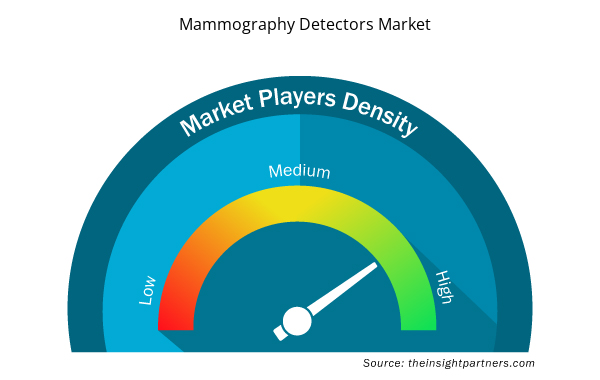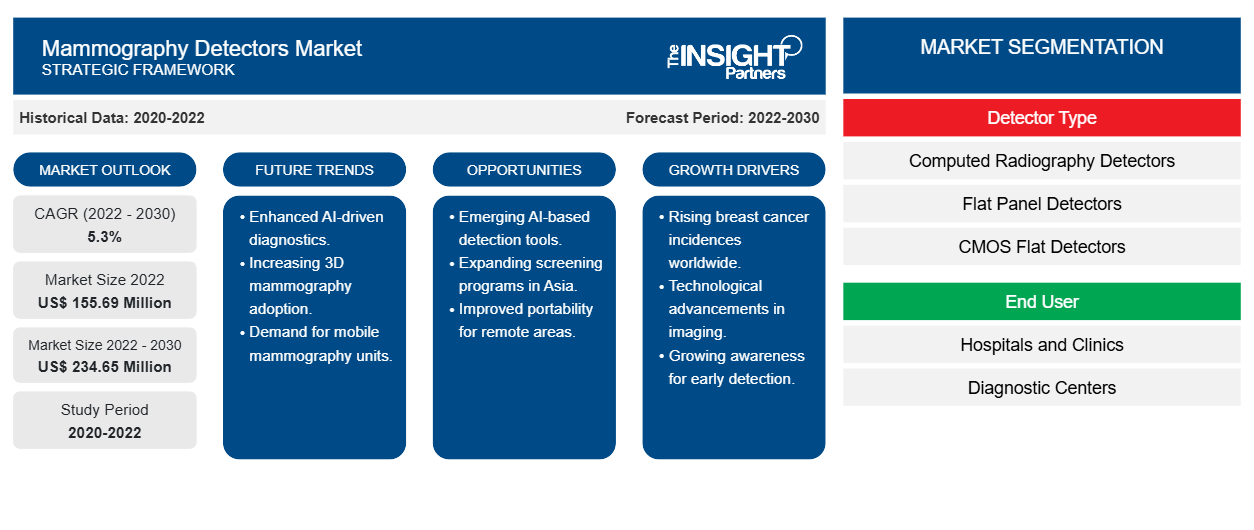[調査レポート] マンモグラフィー検出器の市場規模は、2022年の1億5,569万米ドルから2030年には2億3,465万米ドルに成長すると予測されており、2022年から2030年の間に5.3%のCAGRを記録すると推定されています。
市場洞察とアナリストの見解:
マンモグラフィー検出器ベースの画像処理は、乳がん検出プロセスに不可欠な要素となっています。マンモグラフィーは、低エネルギー X 線を使用して人間の乳房を検査し、明確なしこりや微小石灰化に基づいて乳がんの可能性を検査する診断およびスクリーニング技術であり、これにより早期段階で病気を診断します。マンモグラフィー検出器は、女性に症状が現れる前に低線量の X 線を使用してがんを特定します。市場で入手可能なマンモグラフィー検出器には、コンピューター放射線検出器、フラット パネル検出器、CMOS フラット パネル検出器などがあります。
成長の原動力:
乳がんは世界で最も多く診断されるがん種です。乳がんの一般的な症状には、陥没乳首の出現、乳房の形状の変化、乳房のしこりの発生、皮膚の赤みや鱗状の斑点、乳首の痛みなどがあります。生活習慣の変化、ホルモンの不均衡、遺伝的素因、環境要因などの要因が、乳がんの罹患率の上昇に寄与しています。世界保健機関によると、2020年には世界で約230万人の女性が乳がんと診断され、685,000人が死亡しました。国際がん研究機関は、乳がんの発生率は2040年までに3分の1以上増加し、年間300万人以上の新規症例が発生すると予測しています。乳がんによる年間死亡者数は半分以上増加して約100万人に達すると予想されています。乳がんの罹患率は世界的に増加しており、診断用のマンモグラフィー検出器市場の需要が高まっています。
乳がんは米国で最も一般的ながんの1つです。2022年1月にBreastcancer.orgが発表した報告書によると、米国では女性の8人に1人(約13%)が生涯にわたって浸潤性乳がんを患うとされています。同じ情報源によると、2022年には米国の女性で浸潤性乳がんの新規発症例が287,850件、非浸潤性(原位)乳がんの新規症例が51,400件確認されました。同年、米国では男性の浸潤性乳がんの症例が約2,710件追加で記録されました。男性の約833人に1人が生涯にわたって乳がんを発症するリスクがあります。乳がんはドイツの女性に最も多く見られるがんでもあります。Globocan 2020によると、2020年にドイツでは約69,697件の乳がんの新規症例が報告され、登録されたがん症例全体の11.1%を占めています。この病気により 20,579 人が死亡し、全年齢における乳がんの 5 年罹患率は人口 100,000 人あたり 707.38 人でした。ドイツ連邦乳がん予防局によるマンモグラフィー研究によると、乳がん治療は大きく進歩しているにもかかわらず、この病気で約 17,000 人の女性が死亡しています。乳がん治療には年間約 21.3 億米ドル (20 億ユーロ) の費用がかかります。国民保健サービスのデータによると、イギリスでは生涯に約 7 人に 1 人の女性が乳がんと診断されています。毎年、約 55,000 人の女性が乳がんと診断されています。
乳がんの診断には、X 線マンモグラフィー (低線量 X 線システムを使用した乳房の検査)、超音波検査、磁気共鳴画像法の 3 つの画像技術が使用されます。マンモグラフィーは、乳房組織を検査して悪性腫瘍の有無を確認する標準的な診断およびスクリーニング技術です。この手順では、低エネルギー X 線を使用します。マンモグラフィー検出器は、乳房 X 線を使用して乳がんを検出および診断する装置です。特殊な X 線画像は、乳房組織の異常な成長や変化を見つけるのに役立ち、乳がんの早期発見に役立ちます。
したがって、乳がんの発生率は今後数年間で増加すると予想され、マンモグラフィーは症状が現れていない女性の乳がんを検査する最も効率的な方法であるため、マンモグラフィー検出器市場の成長を牽引します。
要件に合わせてレポートをカスタマイズする
このレポートの一部、国レベルの分析、Excelデータパックなど、あらゆるレポートを無料でカスタマイズできます。また、スタートアップや大学向けのお得なオファーや割引もご利用いただけます。
- このレポートの主要な市場動向を入手してください。この無料サンプルには、市場動向から見積もりや予測に至るまでのデータ分析が含まれます。
レポートのセグメンテーションと範囲:
マンモグラフィー検出器市場は、検出器の種類、エンドユーザー、および地域に基づいて分類されています。検出器の種類に基づいて、市場はコンピューター放射線検出器、フラットパネル検出器、CMOSフラット検出器などに分類されます。マンモグラフィー検出器市場は、エンドユーザー別に、病院と診療所、診断センターに分類されます。マンモグラフィー検出器市場は、地域に基づいて、北米(米国、カナダ、メキシコ)、ヨーロッパ(フランス、ドイツ、英国、スペイン、イタリア、その他のヨーロッパ)、アジア太平洋(中国、インド、日本、オーストラリア、韓国、その他のアジア太平洋)、中東およびアフリカ(サウジアラビア、UAE、南アフリカ、その他の中東およびアフリカ)、南米および中米(ブラジル、アルゼンチン、その他の南米および中米)に分類されます。
セグメント分析:
マンモグラフィー検出器市場は、検出器の種類別に、コンピューター放射線検出器、フラットパネル検出器、CMOSフラット検出器、その他に分類されます。フラットパネル検出器セグメントは、2022年に市場で最大のシェアを占めました。CMOSフラット検出器セグメントは、2022年から2030年の間にマンモグラフィー検出器市場で最高のCAGRを記録すると予想されています。
エンドユーザーに基づいて、マンモグラフィー検出器市場は、病院と診療所、診断センターに分類されます。2022年には、病院と診療所のセグメントが市場の大きなシェアを占め、2022年から2030年の間にさらに高いCAGRを記録すると予想されています。
地域分析:
マンモグラフィー検出器市場は、主に北米、ヨーロッパ、アジア太平洋、中南米、中東およびアフリカに分かれています。2022年には、北米が市場の大きなシェアを獲得しました。2022年には、米国がこの地域で最大の市場シェアを占めました。北米での市場成長は、技術的に高度な検出器への容易なアクセス、乳がん症例の増加、確立された医療インフラの存在に起因しています。米国疾病管理予防センターによると、2020年に米国の女性の間で239,612件の新たな乳がん症例が報告され、そのうち約42,273人が死亡しました。女性10万人あたり119人の新たな乳がん症例が報告され、約19人がこの病気で亡くなりました。乳がん協会の乳がん統計によると、女性の8人に1人(約12%)が生涯に浸潤性乳がんを発症するリスクがあります。
乳がんはカナダの女性に最も多く見られるがんであり、がんによる死亡原因の第 2 位であるため、同国では効率的な診断オプションに対する需要が高まっています。カナダがん協会によると、2022 年には約 28,600 人のカナダ人女性が乳がんと診断され、女性の新規がん症例の約 25% を占めています。カナダ人女性の 8 人に 1 人は、生涯に乳がんを発症すると推定されています。
マンモグラフィー検出器市場の地域別分析
予測期間を通じてマンモグラフィ検出器市場に影響を与える地域的な傾向と要因は、Insight Partners のアナリストによって徹底的に説明されています。このセクションでは、北米、ヨーロッパ、アジア太平洋、中東、アフリカ、南米、中米にわたるマンモグラフィ検出器市場のセグメントと地域についても説明します。

- マンモグラフィー検出器市場の地域別データを入手
マンモグラフィー検出器市場レポートの範囲
| レポート属性 | 詳細 |
|---|---|
| 2022年の市場規模 | 1億5,569万米ドル |
| 2030年までの市場規模 | 2億3,465万米ドル |
| 世界のCAGR(2022年 - 2030年) | 5.3% |
| 履歴データ | 2020-2022 |
| 予測期間 | 2022-2030 |
| 対象セグメント | 検出器の種類別
|
| 対象地域と国 | 北米
|
| 市場リーダーと主要企業プロフィール |
|
市場プレーヤーの密度:ビジネスダイナミクスへの影響を理解する
マンモグラフィー検出器市場は、消費者の嗜好の変化、技術の進歩、製品の利点に対する認識の高まりなどの要因により、エンドユーザーの需要が高まり、急速に成長しています。需要が高まるにつれて、企業は提供を拡大し、消費者のニーズを満たすために革新し、新たなトレンドを活用し、市場の成長をさらに促進しています。
市場プレーヤー密度とは、特定の市場または業界内で活動している企業または会社の分布を指します。これは、特定の市場スペースに、その市場規模または総市場価値に対してどれだけの競合相手 (市場プレーヤー) が存在するかを示します。
マンモグラフィー検出器市場で事業を展開している主要企業は次のとおりです。
- アナロジック株式会社
- シーメンス ヘルシナーズ
- テレダインDALSA
- ヴァレックスイメージング
- 富士フイルムホールディングス
免責事項:上記の企業は、特定の順序でランク付けされていません。

- マンモグラフィー検出器市場のトップキープレーヤーの概要を入手
業界の発展と将来の機会:
主要プレーヤーによるさまざまな取り組み世界のマンモグラフィー検出器市場は以下の通りです。
- 2023 年 1 月、Carestream Health, Inc. は、ノイズの低減と検出器の量子効率の向上により画質が向上した CR マンモグラフィー画像システム用の EHR-M3 スクリーンを発表しました。この新しいスクリーンは、同社のマンモグラフィー機能を搭載した DIRECTVIEW CR マンモグラフィー システムで使用されていた以前のスクリーンの代替として導入されました。この新しいマンモグラフィーソフトウェアは現在、カナダ、ヨーロッパ、南米、オーストラリア、アジア、および世界の他の地域で利用できます。
競争環境と主要企業:
Analogic Corporation、Siemens Healthineers、Teledyne DALSA、Varex Imaging、Fujifilm Holdings、Koninklijke Philips NV、Hologic, Inc.、PerkinElmer、Carestream Health、Canon Medical Systems は、マンモグラフィー検出器市場の主要企業です。これらの企業は、世界中で高まる消費者の需要を満たすために、新しいハイテク製品の導入、既存製品の改良、地理的拡大に注力しています。
- 過去2年間の分析、基準年、CAGRによる予測(7年間)
- PEST分析とSWOT分析
- 市場規模価値/数量 - 世界、地域、国
- 業界と競争環境
- Excel データセット



Report Coverage
Revenue forecast, Company Analysis, Industry landscape, Growth factors, and Trends

Segment Covered
This text is related
to segments covered.

Regional Scope
North America, Europe, Asia Pacific, Middle East & Africa, South & Central America

Country Scope
This text is related
to country scope.
よくある質問
Early breast cancer detection coupled with technological advancement in detectors design , material, and image processing are driving the global mammography detectors market.
The CAGR value of the mammography detectors during the forecasted period of 2020-2030 is 5.3%.
Global mammography detectors market is segmented by region into North America, Europe, Asia Pacific, Middle East & Africa and South & Central America. The market in North America held the largest market share of US$ 63.97 million in 2022 and is expected to grow at a significant rate during the forecast period. North America mammography detectors is segmented into the US, Canada, and Mexico.
Answer: - The flat panel detector type segment dominated the global mammography detectors and held the largest market share of 46.09% in 2022.
A mammography detector is a device used in mammography, a type of medical imaging that uses low-dose X-rays to create detailed images of the breast. The mammography detector is a key component of the mammography system and is responsible for capturing the X-ray images of the breast tissue. It typically consists of an X-ray detector, such as amorphous selenium or amorphous silicon, which converts X-ray photons into electrical signals that can be used to create digital images. These detectors are designed to provide high image quality while minimizing radiation exposure to the patient.
The mammography detectors majorly consists of the players including Analogic Corporation, Siemens Healthineers, Teledyne DALSA, Varex Imaging, Fujifilm Holdings, Koninklijke Philips NV, Hologic, Inc., PerkinElmer, Carestream Health, and Canon Medical Systems.
Trends and growth analysis reports related to Life Sciences : READ MORE..
The List of Companies - Mammography Detectors Market
- Analogic Corporation
- Siemens Healthineers
- Teledyne DALSA
- Varex Imaging
- Fujifilm Holdings
- Koninklijke Philips NV
- Hologic, Inc.
- PerkinElmer
- Carestream Health
- Canon Medical Systems.
The Insight Partners performs research in 4 major stages: Data Collection & Secondary Research, Primary Research, Data Analysis and Data Triangulation & Final Review.
- Data Collection and Secondary Research:
As a market research and consulting firm operating from a decade, we have published and advised several client across the globe. First step for any study will start with an assessment of currently available data and insights from existing reports. Further, historical and current market information is collected from Investor Presentations, Annual Reports, SEC Filings, etc., and other information related to company’s performance and market positioning are gathered from Paid Databases (Factiva, Hoovers, and Reuters) and various other publications available in public domain.
Several associations trade associates, technical forums, institutes, societies and organization are accessed to gain technical as well as market related insights through their publications such as research papers, blogs and press releases related to the studies are referred to get cues about the market. Further, white papers, journals, magazines, and other news articles published in last 3 years are scrutinized and analyzed to understand the current market trends.
- Primary Research:
The primarily interview analysis comprise of data obtained from industry participants interview and answers to survey questions gathered by in-house primary team.
For primary research, interviews are conducted with industry experts/CEOs/Marketing Managers/VPs/Subject Matter Experts from both demand and supply side to get a 360-degree view of the market. The primary team conducts several interviews based on the complexity of the markets to understand the various market trends and dynamics which makes research more credible and precise.
A typical research interview fulfils the following functions:
- Provides first-hand information on the market size, market trends, growth trends, competitive landscape, and outlook
- Validates and strengthens in-house secondary research findings
- Develops the analysis team’s expertise and market understanding
Primary research involves email interactions and telephone interviews for each market, category, segment, and sub-segment across geographies. The participants who typically take part in such a process include, but are not limited to:
- Industry participants: VPs, business development managers, market intelligence managers and national sales managers
- Outside experts: Valuation experts, research analysts and key opinion leaders specializing in the electronics and semiconductor industry.
Below is the breakup of our primary respondents by company, designation, and region:

Once we receive the confirmation from primary research sources or primary respondents, we finalize the base year market estimation and forecast the data as per the macroeconomic and microeconomic factors assessed during data collection.
- Data Analysis:
Once data is validated through both secondary as well as primary respondents, we finalize the market estimations by hypothesis formulation and factor analysis at regional and country level.
- Macro-Economic Factor Analysis:
We analyse macroeconomic indicators such the gross domestic product (GDP), increase in the demand for goods and services across industries, technological advancement, regional economic growth, governmental policies, the influence of COVID-19, PEST analysis, and other aspects. This analysis aids in setting benchmarks for various nations/regions and approximating market splits. Additionally, the general trend of the aforementioned components aid in determining the market's development possibilities.
- Country Level Data:
Various factors that are especially aligned to the country are taken into account to determine the market size for a certain area and country, including the presence of vendors, such as headquarters and offices, the country's GDP, demand patterns, and industry growth. To comprehend the market dynamics for the nation, a number of growth variables, inhibitors, application areas, and current market trends are researched. The aforementioned elements aid in determining the country's overall market's growth potential.
- Company Profile:
The “Table of Contents” is formulated by listing and analyzing more than 25 - 30 companies operating in the market ecosystem across geographies. However, we profile only 10 companies as a standard practice in our syndicate reports. These 10 companies comprise leading, emerging, and regional players. Nonetheless, our analysis is not restricted to the 10 listed companies, we also analyze other companies present in the market to develop a holistic view and understand the prevailing trends. The “Company Profiles” section in the report covers key facts, business description, products & services, financial information, SWOT analysis, and key developments. The financial information presented is extracted from the annual reports and official documents of the publicly listed companies. Upon collecting the information for the sections of respective companies, we verify them via various primary sources and then compile the data in respective company profiles. The company level information helps us in deriving the base number as well as in forecasting the market size.
- Developing Base Number:
Aggregation of sales statistics (2020-2022) and macro-economic factor, and other secondary and primary research insights are utilized to arrive at base number and related market shares for 2022. The data gaps are identified in this step and relevant market data is analyzed, collected from paid primary interviews or databases. On finalizing the base year market size, forecasts are developed on the basis of macro-economic, industry and market growth factors and company level analysis.
- Data Triangulation and Final Review:
The market findings and base year market size calculations are validated from supply as well as demand side. Demand side validations are based on macro-economic factor analysis and benchmarks for respective regions and countries. In case of supply side validations, revenues of major companies are estimated (in case not available) based on industry benchmark, approximate number of employees, product portfolio, and primary interviews revenues are gathered. Further revenue from target product/service segment is assessed to avoid overshooting of market statistics. In case of heavy deviations between supply and demand side values, all thes steps are repeated to achieve synchronization.
We follow an iterative model, wherein we share our research findings with Subject Matter Experts (SME’s) and Key Opinion Leaders (KOLs) until consensus view of the market is not formulated – this model negates any drastic deviation in the opinions of experts. Only validated and universally acceptable research findings are quoted in our reports.
We have important check points that we use to validate our research findings – which we call – data triangulation, where we validate the information, we generate from secondary sources with primary interviews and then we re-validate with our internal data bases and Subject matter experts. This comprehensive model enables us to deliver high quality, reliable data in shortest possible time.


 このレポートの無料サンプルを入手する
このレポートの無料サンプルを入手する